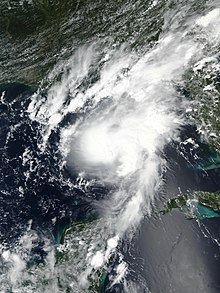 Hurricane Marco approaching Louisiana at peak intensity on August 23 | |
| Meteorological history | |
|---|---|
| Formed | August 20, 2020 |
| Remnant low | August 25, 2020 |
| Dissipated | August 26, 2020 |
| Category 1 hurricane | |
| 1-minute sustained (SSHWS/NWS) | |
| Highest winds | 75 mph (120 km/h) |
| Lowest pressure | 991 mbar (hPa); 29.26 inHg |
| Overall effects | |
| Fatalities | None |
| Economic losses | >$35 million (2020 USD) |
| Areas affected | Central America, western Caribbean, Yucatán Peninsula, Gulf Coast of the United States |
| IBTrACS | |
Part of the 2020 Atlantic hurricane season | |
Hurricane Marco was the first of two tropical cyclones to threaten the Gulf Coast of the United States within a three-day period. The thirteenth named storm and third hurricane of the record-breaking 2020 Atlantic hurricane season, Marco developed from a fast-moving tropical wave west of the Windward Islands and south of Jamaica on August 20. The fast motion of the wave inhibited intensification initially, but as the wave slowed down and entered a more favorable environment, the system developed into a tropical depression, which in turn rapidly intensified into a strong tropical storm. Due to strong wind shear, Marco's intensification temporarily halted. However, after entering the warm waters of the Gulf of Mexico on August 23, Marco briefly intensified into a hurricane, only to quickly weaken later that evening due to another rapid increase in wind shear. Marco subsequently weakened to a tropical depression before degenerating into a remnant low early the next morning. Marco's remnants subsequently dissipated on August 26.
Heavy rains across the Yucatán Peninsula caused river rises and flooding throughout the region. One person was indirectly killed in Tapachula, Mexico, due to the storm, although this was not included in the official death toll. Impacts in the United States were generally minor, as the storm was considerably weakened by the time it impacted the Gulf Coast.
Meteorological history

Tropical storm (39–73 mph, 63–118 km/h)
Category 1 (74–95 mph, 119–153 km/h)
Category 2 (96–110 mph, 154–177 km/h)
Category 3 (111–129 mph, 178–208 km/h)
Category 4 (130–156 mph, 209–251 km/h)
Category 5 (≥157 mph, ≥252 km/h)
Unknown
At 00:00 UTC on August 16, the National Hurricane Center (NHC) began monitoring a westward-moving tropical wave over the Central Atlantic that had the potential for development.[2][3] The disturbance quickly moved westward at a speed over 20 mph (32 km/h), which initially limited its development as it passed through the Windward Islands and into the Caribbean Sea. The system slowed down and gradually organized south of the Greater Antilles on August 19.[4] By 15:00 UTC on August 20, satellite imagery revealed that the wave had developed a well-defined low-level center, prompting the NHC to designate it Tropical Depression Fourteen, forming after Tropical Depression Thirteen which would become Hurricane Laura.[5][6] Post-storm analysis found that the system formed nine hours earlier at 06:00 UTC.[3] At the time the system was located 235 miles (378 km) east of the Nicaragua–Honduras border.[5] The storm continued westward toward Honduras, before making a sharp turn northward. Despite favorable conditions, the storm initially failed to intensify, with pulsing convection around a poorly defined center. Eventually, the storm's center became better defined and a small but persistent cluster of convection formed over it. This allowed the depression to intensify, and the NHC upgraded the system to Tropical Storm Marco in the northwest Caribbean at 00:00 UTC on August 22.[3] This was the earliest 13th named storm ever recorded in the Atlantic basin, breaking the record set by Hurricane Maria of 2005 by 11 days.[7]
Marco was able to strengthen quickly as a small system, reaching its initial peak intensity of 65 mph (100 km/h) and 992 mbar (29.29 inHg) just 18 hours after being named,[3] with an almost closed eyewall being observed by Hurricane Hunters.[8][9] Contrary to prior predictions, Marco's track was shifted eastward at the 21:00 UTC advisory on August 22, as the system moved north-northeastward instead of north-northwestward, introducing the possibility of successive landfalls around Louisiana from both Laura and Marco.[9][10] An increase of southwesterly wind shear brought an abrupt end to the strengthening trend, as Marco moved through the Yucatán Channel, with the storm's minimum central pressure rising slightly and the eyewall mostly dissipating as the storm took on a sheared appearance.[11] This weakening period proved to be short-lived, as the shear relaxed somewhat when Marco moved into the warm waters of the Gulf of Mexico on August 23. Slow but steady strengthening resumed and data from another Hurricane Hunter reconnaissance aircraft discovered sustained winds at hurricane strength in the northeastern eyewall.[12] Marco strengthened into a Category 1 hurricane at 12:00 UTC on August 23, and simultaneously reached its peak intensity with 1-minute sustained winds of 75 mph (120 km/h) and a minimum central pressure of 991 mbar (29.26 inHg).[3]

This strengthening proved to be short-lived, however, as upper-level wind shear increased again over the storm.[13] This caused Marco to weaken back to a tropical storm by 00:00 UTC on August 24,[3] and the center of circulation became displaced from the storm's convection.[14] Wind shear continued to plague the system as it turned westward near the Louisiana coastline, and Marco rapidly weakened to minimal tropical storm strength by 18:00 UTC.[15] At 00:00 UTC on August 24, Marco passed just south of the mouth of the Mississippi River, with 1-minute sustained winds at 40 mph (65 km/h) and a central pressure of 1,006 mbar (29.71 inHg), although the strongest winds were displaced in convection that was over waters well northeast of the storm's center.[3] Operationally, the NHC said that the storm made landfall here, but that was changed in post-storm analysis because of data from weather stations in Southwest Pass indicating that Marco stayed offshore.[3][16] Afterward, Marco weakened further and fell to tropical depression intensity just offshore of Louisiana, near Grand Isle, at 03:00 UTC on August 25, before degenerating into a remnant low three hours later.[3][17][18] The remnant low continued to spin down as it slowly moved westward along the Louisiana coastline, ahead of the approaching Hurricane Laura, before opening up into a trough at 00:00 UTC on the next day.[3]
Preparations

Honduras issued tropical storm watches along its coastline when Tropical Depression Fourteen was designated, before quickly upgrading to warnings hours later.[3] Tropical Storm Watches, and later Tropical Storm Warnings and Hurricane Watches, were also issued for the eastern side of the Yucatán Peninsula, as the storm was first predicted to move over the peninsula as a strong tropical storm.[19][20] When Marco moved to the north instead of northwest, a Tropical Storm Warning was issued by the Government of Cuba for the Pinar del Río Province and the Isle of Youth.[21][22]
Tropical Storm, Hurricane, and Storm Surge Watches were issued in Louisiana, Mississippi, and Alabama when Marco's forecast track shifted significantly eastward on August 22.[23] Many of these watches were upgraded to warnings as the storm continued its approach.[21] In the state of Texas, the Padre Island National Seashore closed on August 22 in preparation for the hurricane.[24] In Mississippi, mandatory evacuation orders were in place on August 23 at the Gulfport and Biloxi marinas and the harbor in Long Beach.[25] All boats were ordered to be moved by sundown that same day.[26] In Gulfport, the fuel dock was closed.[27] However, all the warnings were eventually downgraded and canceled when the storm rapidly weakened as it approached the coast.[21] Six hundred additional resources from were requested from Alabama Power, Georgia Power, and other power crews to help restoration efforts.[28] A tornado watch was issued for southeast Alabama, the Florida Panhandle, Southwest Georgia, and United States coastal waters at 20:40 UTC on August 24.[29]
Impacts

Central America, Mexico, and Cuba
The Instituto Meteorológico Nacional of Costa Rica reported that heavy rain from the indirect effects of Marco affected parts of the country for three days. In Santa Cruz, Guanacaste Province, accumulations reached 17.0 in (431 mm), more than twice the average August rainfall of 9.1 in (231 mm). Areas in and around Santa Cruz reported flooding.[30]
In Mexico, an indirect death occurred in Tapachula, Chiapas. Despite this, the NHC did not attribute Marco to any deaths in their post-storm report.[3] Rainfall totals were as high as 186.4 millimeters (18.64 cm), with the states Veracruz, Oaxaca, and Chiapas worst affected by heavy rains.[31] In some municipalities of Chiapas, such as Tapachula, Escuintla and Acacoyagua, growth of rivers from nearby mountains led to flooding.[32] Losses in Mexico and Costa Rica were estimated by Aon to be in the "tens of millions" (USD).[1]
While traversing the Yucatán Channel, Marco brought heavy rain to parts of Pinar del Río Province in Cuba on August 23. The town of Isabel Rubio saw the greatest accumulations at 3.8 in (97 mm) of rainfall.[33] Minor flooding occurred in Mantua and Sandino. A few trees were uprooted during the storm.[34]
United States

Due to the sheared nature of the storm as it came ashore in the United States, rain bands extended as far northeast as Virginia. A tornado warning was issued for a storm just northeast of Panama City, Florida. Another tornado warning was issued for a storm near Charleston, South Carolina.[35] Numerous special marine warnings were also issued due to possible waterspouts.[36] However, no tornadoes nor waterspouts were confirmed. Rainfall totals were highest along the Florida Panhandle, peaking at 13.17 inches (335 mm) near Apalachicola on Monday morning.[3] Several roadways and a hotel were flooded in Panama City Beach that evening as well.[37][38] Heavy rainfall extended much further inland with flash flood warnings being issued as far northeast as the North Carolina—Virginia border.[39] Due to Marco being much weaker than anticipated, no wind damage occurred and the peak wind gust from the storm was only 38 mph (61 km/h), which was recorded in Petit Bois Island, Mississippi.[37] The remnants of the storm brought heavy rainfall and flash flooding to Southeastern Oklahoma on August 26 before dissipating.[40] Overall, Marco caused at least $25 million USD in insured losses throughout the impacted areas, as estimated by Aon.[1]
See also
- Tropical cyclones in 2020
- Other storms of the same name
- List of Category 1 Atlantic hurricanes
- Tropical Storm Arlene (2005) – a similar storm that affected similar areas
- Hurricane Cindy (2005) – a storm that had a similar track
- Hurricane Nate (2017) – also caused flooding in Central America and Cuba
- Tropical Storm Alberto (2018) – a storm that affected similar areas
References
- ^ a b c "Global Catastrophe Recap September 2020" (PDF). Aon. October 8, 2020. Archived (PDF) from the original on October 8, 2020. Retrieved October 8, 2020.
- ^ Stewart, Stacy (August 16, 2020). "Five-Day Graphical Tropical Weather Outlook". www.nhc.noaa.gov. Miami, Florida: National Hurricane Center. Archived from the original on September 13, 2020. Retrieved August 20, 2020.
- ^ a b c d e f g h i j k l m Beven, John; Berg, Robbie (March 31, 2021). "Tropical Cyclone Report: Hurricane Marco" (PDF). Miami, Florida: National Hurricane Center. Archived (PDF) from the original on June 22, 2021. Retrieved April 7, 2021.
- ^ Latto, Andrew (August 19, 2020). "Five-Day Graphical Tropical Weather Outlook". www.nhc.noaa.gov. Miami, Florida: National Hurricane Center. Archived from the original on September 13, 2020. Retrieved August 20, 2020.
- ^ a b Berg, Robbie (August 20, 2020). "Tropical Depression Fourteen Public Advisory Number 1". www.nhc.noaa.gov. Miami, Florida: National Hurricane Center. Archived from the original on September 13, 2020. Retrieved August 20, 2020.
- ^ "Double trouble: Pair of tropical systems could near US as powerful storms early next week". USA TODAY. Retrieved August 5, 2023.
- ^ Kimberly Miller, Doyle Rice (August 21, 2020). "Two Gulf hurricanes at the same time? Tropical Storm Laura has formed". www.usatoday.com. Archived from the original on August 28, 2020. Retrieved August 21, 2020.
- ^ Berg, Robbie (August 22, 2020). "Tropical Storm Marco Discussion Number 9". www.nhc.noaa.gov. Miami, Florida: National Hurricane Center. Archived from the original on October 19, 2020. Retrieved August 24, 2020.
- ^ a b Berg, Robbie (August 22, 2020). "Tropical Storm Marco Discussion Number 10". www.nhc.noaa.gov. Miami, Florida: National Hurricane Center. Archived from the original on September 13, 2020. Retrieved August 22, 2020.
- ^ Erdman, Jonathan (August 22, 2020). "Tropical Storms Laura and Marco Could Deliver Back-to-Back Landfalls on U.S. Gulf Coast; Here's How Rare That Is". weather.com. The Weather Company. Archived from the original on August 22, 2020. Retrieved August 22, 2020.
- ^ Zelinsky, David (August 23, 2020). "Tropical Storm Marco Discussion Number 11". www.nhc.noaa.gov. Miami, Florida: National Hurricane Center. Archived from the original on September 13, 2020. Retrieved August 24, 2020.
- ^ Latto, Andrew (August 23, 2020). "Hurricane Marco Tropical Cyclone Update". www.nhc.noaa.gov. Miami, Florida: National Hurricane Center. Archived from the original on September 13, 2020. Retrieved August 23, 2020.
- ^ Latto, Andrew (August 23, 2020). "Hurricane Marco Discussion Number 14". www.nhc.noaa.gov. Miami, Florida: National Hurricane Center. Archived from the original on September 13, 2020. Retrieved August 24, 2020.
- ^ Zelinsky, David (August 24, 2020). "Hurricane Marco Discussion Number 15". www.nhc.noaa.gov. Miami, Florida: National Hurricane Center. Archived from the original on September 13, 2020. Retrieved August 24, 2020.
- ^ Latto, Andrew (August 24, 2020). "Tropical Storm Marco Special Discussion Number 18". www.nhc.noaa.gov. Miami, Florida: National Hurricane Center. Archived from the original on October 18, 2020. Retrieved August 27, 2020.
- ^ Zelinsky, David (August 24, 2020). "Tropical Storm Marco Tropical Cyclone Update". www.nhc.noaa.gov. Miami, Florida: National Hurricane Center. Archived from the original on September 13, 2020. Retrieved August 27, 2020.
- ^ Zelinsky, David (August 25, 2020). "Tropical Depression Marco Discussion Number 20". www.nhc.noaa.gov. Miami, Florida: National Hurricane Center. Archived from the original on October 10, 2020. Retrieved August 27, 2020.
- ^ Stewart, Stacy R. (August 25, 2020). "Post-Tropical Cyclone Marco Discussion Number 21". www.nhc.noaa.gov. Archived from the original on October 13, 2020. Retrieved August 27, 2020.
- ^ "Mexico Issues Hurricane Watch, Tropical Storm Warning for Parts of Yucatan Peninsula". VOA. Archived from the original on February 24, 2023. Retrieved February 24, 2023.
- ^ Magazine, Yucatán (August 21, 2020). "Hurricane watch for Yucatan Peninsula as Marco takes shape". Yucatán Magazine. Archived from the original on February 24, 2023. Retrieved February 24, 2023.
- ^ a b c "Hurricane Marco Advisory Archive". www.nhc.noaa.gov. Miami, Florida: National Hurricane Center. 2020. Archived from the original on September 1, 2020. Retrieved August 24, 2020.
- ^ "Hurricane Marco, Tropical Storm Laura form dual threat to Gulf Coast; Florida Keys under tropical storm watch". Orlando Sentinel. August 23, 2020. Archived from the original on August 24, 2020. Retrieved August 23, 2020.
- ^ "Hurricane, Storm Surge Watches Issued for Northern Gulf Coast as Marco Enters the Gulf of Mexico". The Weather Channel. Archived from the original on January 11, 2021. Retrieved February 24, 2023.
- ^ Padre Island National Seashore to close due to Tropical Storm Marco Archived January 7, 2023, at the Wayback Machine, Caller Times, August 22, 2020
- ^ Powell, Akim. "Gulfport issues mandatory marina evacuation along with Biloxi, Long Beach". WLOX13. Archived from the original on August 24, 2020. Retrieved February 24, 2023.
- ^ Walck, Lauren (August 23, 2020). "Live updates: Marco downgraded to tropical storm as Laura intensifies near Cuba". Sun Herald.
- ^ "Marco downgraded to tropical storm as Laura intensifies near Cuba". sunherald.com. Sun Herald. August 23, 2020. Retrieved August 24, 2020.
- ^ Broom, Brian. "Hurricanes in the Gulf: Coastal Mississippi residents brace for back-to-back storms". The Clarion-Ledger. Retrieved February 25, 2023.
- ^ "Storm Prediction Center Tornado Watch 448". www.spc.noaa.gov. Archived from the original on October 10, 2020. Retrieved August 24, 2020.
- ^ Solano, Hugo (August 24, 2020). "Afectación por tormenta Marco dejó en tres días en Santa Cruz más del doble de la lluvia que cae en todo el mes". La Nación (in Spanish). Archived from the original on August 25, 2020. Retrieved August 24, 2020.
- ^ "Mexico – Rain From Storm Marco Triggers Floods in Southern States – FloodList". floodlist.com. Retrieved February 24, 2023.
- ^ Fredy Martín Pérez (August 23, 2020). "Muere niña en Chiapas por afectaciones de la tormenta tropical "Marco"". El Universal. Archived from the original on March 3, 2021. Retrieved August 23, 2020.
- ^ ""Laura" afecta con lluvias a Dominicana y "Marco" avanza por el Golfo de México". Vanguardia (in Spanish). Institute of Meteorology of the Republic of Cuba. August 23, 2020. Archived from the original on August 23, 2020. Retrieved August 24, 2020.
- ^ "Tormenta Marco deja inundaciones en Pinar del Río". Periódico Cubano (in Spanish). August 23, 2020. Archived from the original on October 29, 2020. Retrieved August 24, 2020.
- ^ Herzmann, Daryl. "IEM :: Storm Based Warning Polygon Visual Summary". mesonet.agron.iastate.edu. Archived from the original on February 24, 2023. Retrieved August 24, 2020.
- ^ Herzmann, Daryl. "IEM :: Storm Based Warning Polygon Visual Summary". mesonet.agron.iastate.edu. Archived from the original on February 24, 2023. Retrieved August 24, 2020.
- ^ a b "Marco Weakens and May Still Bring Heavy Rain to Parts of Gulf Coast Into Tuesday". The Weather Channel. Archived from the original on August 26, 2020. Retrieved August 25, 2020.
- ^ "Panama City Beach Floods as Storm Marco Hangs in Gulf". www.yahoo.com. Archived from the original on February 24, 2023. Retrieved February 24, 2023.
- ^ Herzmann, Daryl. "IEM :: Storm Based Warning Polygon Visual Summary". mesonet.agron.iastate.edu. Archived from the original on February 24, 2023. Retrieved August 24, 2020.
- ^ Herzmann, Daryl. "IEM :: Storm Based Warning Polygon Visual Summary". mesonet.agron.iastate.edu. Archived from the original on December 18, 2022. Retrieved August 30, 2020.
External links
- The National Hurricane Center's Advisory Archive on Hurricane Marco
- National Hurricane Center (NHC)
- Weather Prediction Center (WPC)
Tropical cyclones of the 2020 Atlantic hurricane season | ||
|---|---|---|
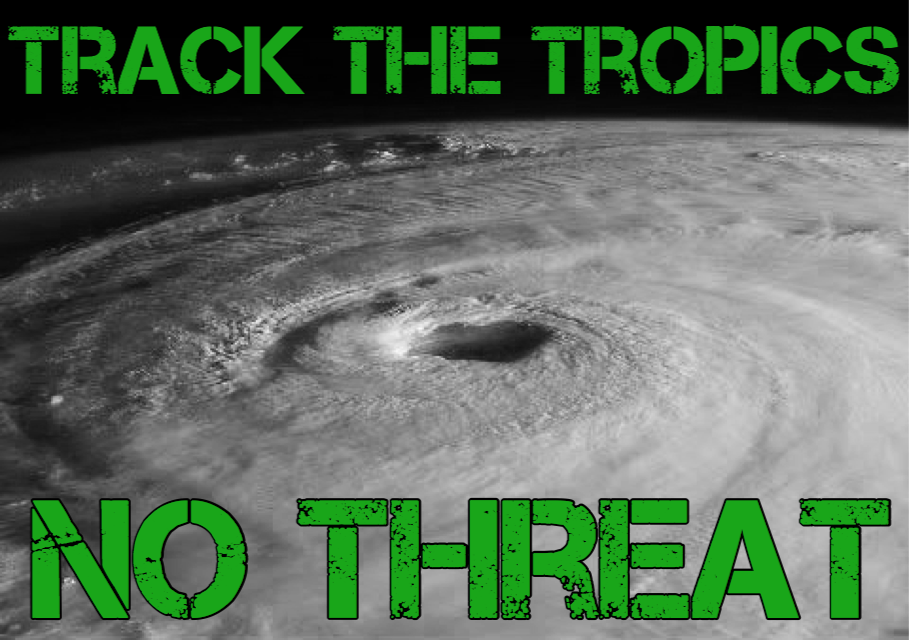
![[Map of 1950-2017 CONUS Hurricane Strikes]](http://www.nhc.noaa.gov/climo/images/conus_strikes_sm.jpg)
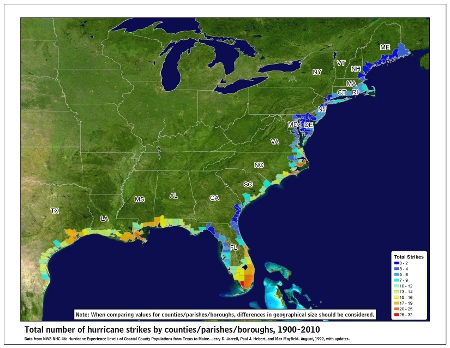
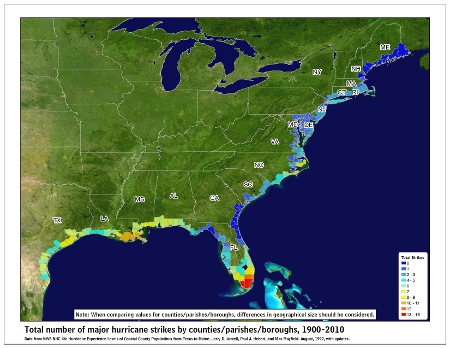
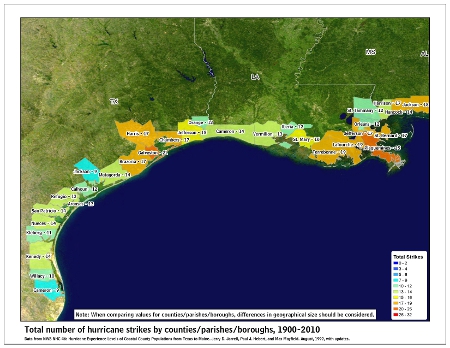
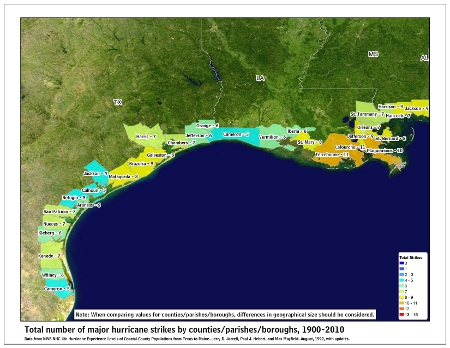
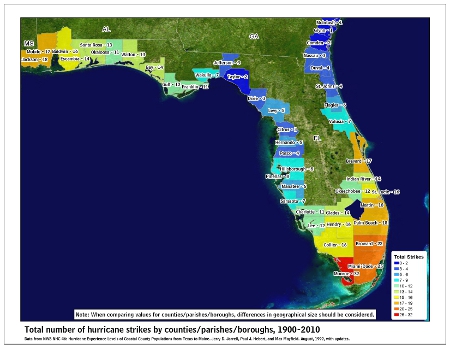

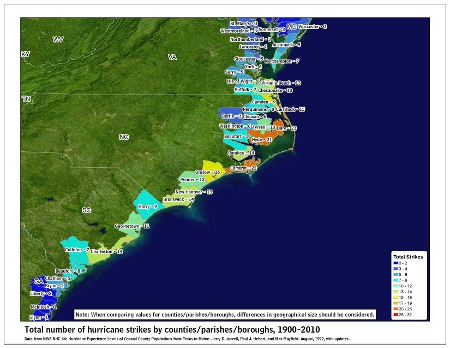
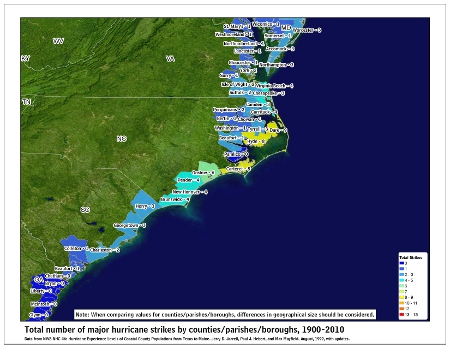
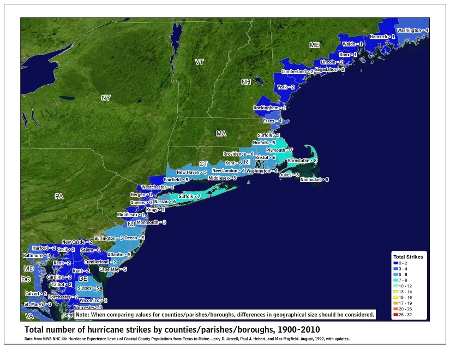
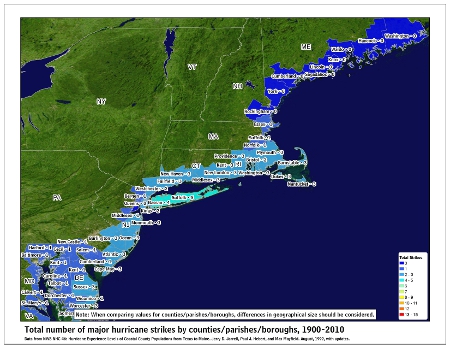

Facebook Comments